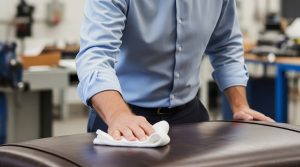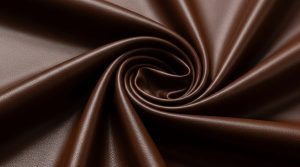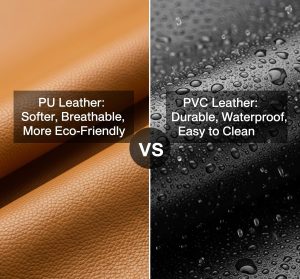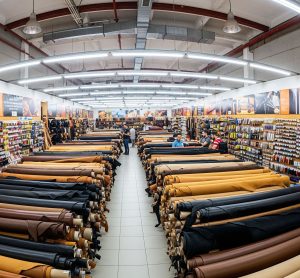
Leather goods—whether it’s a sleek sofa, a stylish jacket, or a favorite handbag—add a touch of elegance to our lives. But with regular use, they can start to pick up odors from pets, spills, or just everyday life. When this happens, many of us reach for a quick fix like a fabric refresher, such as Febreze or similar spray-on odor eliminators. But the big question is: Can you use fabric refresher on leather? The answer isn’t a simple yes or no—it depends on the leather, the product, and how you approach it. In this blog post, we’ll explore whether fabric refreshers are safe for leather, their potential risks, and the best ways to keep your leather items smelling fresh and looking pristine.
What Are Fabric Refreshers?
Fabric refreshers are spray-on products designed to neutralize and eliminate odors from textiles like upholstery, curtains, and clothing. Brands like Febreze, Lysol, or Glade work by trapping odor molecules, neutralizing them, and leaving behind a light, pleasant scent. These products are formulated for porous, woven materials—think cotton, polyester, or linen—that can absorb both odors and the refresher’s ingredients.
The key components of most fabric refreshers include water, alcohol, fragrance, and odor-neutralizing agents like cyclodextrin. While these work wonders on fabrics, leather is a different beast altogether, and applying fabric refreshers to it requires careful consideration.
Understanding Leather: Why It’s Different
Leather is a natural material made from animal hides that are tanned and treated to become durable and supple. Unlike fabric, which is woven and porous, leather has a smoother, less absorbent surface. Its properties vary depending on the type:
Full-Grain Leather: The most natural and durable, with a protective outer layer that resists moisture but can still absorb some liquids over time.
Top-Grain Leather: Slightly processed, often with a finish that makes it less porous but still sensitive to chemicals.
Bonded or Faux Leather: Made from leather scraps or synthetics, these are often coated with polyurethane, making them less absorbent but still vulnerable to damage.
Leather’s non-porous nature means it doesn’t soak up odors as readily as fabric, but it can still trap smells, especially in humid conditions or with prolonged exposure. The challenge lies in how leather reacts to moisture, chemicals, and fragrances—key ingredients in fabric refreshers.
Can You Use Fabric Refresher on Leather?
So, can you spritz fabric refresher on your leather sofa or jacket? The short answer is: It’s not recommended, but it’s not an absolute no. Let’s break it down.
Potential Risks of Using Fabric Refresher on Leather
- Moisture Damage: Fabric refreshers contain water, which can penetrate leather’s surface, especially unfinished or aniline leather. Excess moisture may lead to stains, discoloration, or even cracking if the leather dries out improperly.
- Chemical Reactions: The alcohol and fragrance compounds in refreshers can strip leather of its natural oils, causing it to dry out, fade, or develop a sticky residue. This is particularly true for high-quality, untreated leathers.
- Finish Damage: Many leathers have protective coatings that can be dulled or degraded by the chemicals in fabric refreshers, leading to a worn or patchy appearance.
- Odor Buildup: While the refresher might mask odors temporarily, it doesn’t address the root cause. The fragrance could mix with existing smells, creating an unpleasant combination over time.
When It Might Be Okay
In some cases, using a fabric refresher on leather might not cause immediate harm, particularly with:
- Coated or Faux Leather: These materials are less absorbent and more resistant to chemicals, so a light mist of fabric refresher is less likely to penetrate or damage them.
- Well-Sealed Leather: Leather with a heavy protective finish (common in furniture) can sometimes tolerate a small amount of refresher, provided it’s wiped off quickly.
Even in these scenarios, caution is key. Always test the product on a small, inconspicuous area first—like the underside of a sofa or an inner seam of a jacket—and monitor for any adverse effects, such as discoloration or stickiness.
Why Fabric Refresher Isn’t the Best Choice
While fabric refreshers are convenient, they’re not tailored for leather’s unique needs. Leather requires specialized care to maintain its appearance and longevity. Using a product designed for fabrics can disrupt the leather’s natural balance, leading to issues that are costly or impossible to reverse. Instead of masking odors, it’s better to address them directly with leather-safe methods.
Safe Alternatives to Freshen Leather
Thankfully, there are plenty of effective, leather-friendly ways to banish odors and keep your items smelling great. Here’s how:
- Regular Cleaning:Dust and dirt can trap odors, so wipe down leather with a soft, damp cloth weekly. For deeper cleaning, use a leather cleaner specifically formulated for your item’s type (e.g., saddle soap for unfinished leather or a pH-balanced cleaner for furniture).
- Leather Conditioner:After cleaning, apply a leather conditioner to restore moisture and prevent drying. Many conditioners have a mild, pleasant scent that can help neutralize odors naturally.
- Baking Soda:For stubborn smells, sprinkle baking soda inside leather shoes, bags, or on a cloth placed near furniture. Let it sit overnight to absorb odors, then vacuum or wipe it away. Be cautious not to let baking soda sit directly on leather for too long, as it can dry it out.
- White Vinegar Solution:Mix equal parts water and white vinegar, dampen a cloth with the solution, and gently wipe the leather. Vinegar neutralizes odors without harsh chemicals. Follow up with a dry cloth and conditioner to restore moisture.
- Activated Charcoal:Place activated charcoal packets or bags near or inside leather items. Charcoal is a natural odor absorber and works well for shoes, bags, or car interiors.
- Ventilation:Sometimes, all leather needs is fresh air. Place your item in a well-ventilated area (out of direct sunlight) for a day to let odors dissipate naturally.
Tips for Using Fabric Refresher (If You Must)
If you’re in a pinch and decide to use a fabric refresher on leather, follow these precautions:
Test First: Spray a small amount on a hidden area and wait 24 hours to check for damage.
Use Sparingly: Mist lightly from a distance to avoid saturating the leather.
Wipe Immediately: Use a dry cloth to remove excess liquid before it soaks in.
Condition Afterward: Apply a leather conditioner to counteract any drying effects.
Even with these steps, fabric refreshers remain a risky choice compared to leather-specific solutions.
Caring for Your Leather Long-Term
To keep leather odor-free and in top shape, adopt these habits:
- Store Properly: Keep leather items in a cool, dry place with good airflow to prevent musty smells.
- Avoid Moisture: Wipe up spills immediately and avoid storing leather in humid environments.
- Clean Regularly: Routine maintenance prevents odor buildup and extends leather’s lifespan.
- Use Leather-Safe Products: Stick to cleaners and conditioners designed for leather to avoid unintended damage.
Conclusion: Skip the Fabric Refresher
While it’s tempting to grab a bottle of fabric refresher for a quick odor fix, it’s not the best choice for leather. The risks—moisture damage, chemical reactions, and finish degradation—outweigh the temporary benefits. Instead, opt for leather-safe methods like cleaning, conditioning, or using natural odor absorbers like baking soda or charcoal. These approaches not only eliminate smells but also preserve your leather’s beauty and durability.
Have you ever used a fabric refresher on leather? Share your experience in the comments—I’d love to hear how it turned out! For now, treat your leather with the care it deserves, and it’ll stay fresh and fabulous for years to come.







